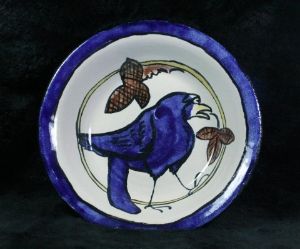
I was asked recently how I do my maiolica. I need to preface
as I've been doing maiolica on and off since I started playing in clay, but
with all this time, I am by all means no expert.
Maiolica is the Italian name for tin glazed pottery. It was
supposedly named after the island of Mallorca, which is where much of these
pots originally were traded. The idea of tin glazing when it was being
developed around 9th century was to replicate porcelain, especially the very
popular Chinese blue-on-white ware. Porcelain is not an easily found clay
throughout Europe and the middle east pre-1600.
Piccolopasso wrote a book which described the period
techniques of Italian maiolica in the 16th century. As with many glazes of the
time, lead was a flux (helped the glazes melt at certain temperatures) and tin
was used as a opacifier.
The idea of tin glazing
is taking a bisqued clay surface (usually either gray or red earthenware was
used) and covering it with a white base glaze. Colorants are used to decorate
the white pot, then fired together. The white (blanco layer) and underglazes
meld together to form a unified, smooth surface. There was also the technique
of using a clear across the decorated piece.
Tin glazing is a very specific technique. In the middle
east, there were techniques that they did in order to get a white base and
decorate, however most of that didn't use tin glazing. Much of that was either
using Fritware (which is a porcelain like clay body, only closer to feldspar,
thus it's name) or a white slip as the base (slip is a watered down clay to a
milkshake consistency).
There are numerous
books and videos on this very popular technique. Modernly, there are numerous ways to achieve
the tin glazed look. The first, and most obvious is use a tin glaze and then
use stains for the colors. There are many recipes online for good
"maiolica" glazes as well as how to use the stains/colorants.
Here is a link to Linda Arbuckle's Maiolica base glaze which
fires at cone 04.
http://ceramicartsdaily.org/ceramic-glaze-recipes/low-fire-glaze-recipes/linda-arbuckles-majolica-glaze-recipe-cone-04-oxidation/
And another with
colorant information: http://ceramicsweb.org/articles/arbucklemajolica.html
If you can't mix your own glazes, there are numerous glaze
companies that make "maiolica" specific glazes and
underglazes/colorant/paints that are compatible. Duncan makes a white base
glaze that works fine. They have a few available. Contact Duncan for over glaze
compatibility. Their EZ line (ez stroke) works well for the colored sections
and it does work with the Arbuckle base.
Duncan IN1653 Downright White is a reasonable base.
Colorobbia (and
Italian glaze company) has a Maiolica White and an entire line of compatible
underglazes (Bellissino line). Aamaco
has an entire line specifically for tin glazing (check out their majolica gloss
glazes... They have Decorating Color sets that all work together).
My experience has mostly been with my own mixed maiolica
base glaze which is similar to the Arbuckle base. I've used Duncan bases in the
past as well, either a white base like the Downright White and EZ paints or I
used the Duncan concepts (Artic white 101 as base and the rest of that line to
decorate, then a clear across everything to seal. All Duncan.
The underglaze route with the clear is something I've seen
the majority of historical potters do. They are very reliable and I've used
them for over 15 years doing many different techniques. There are many ways
and resources for this technique. It's always best to do test tiles and
experiment first with any new glaze to make sure you understand how they work
before you commit it to a full piece.

